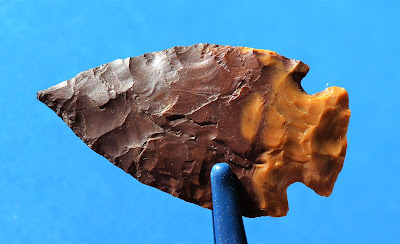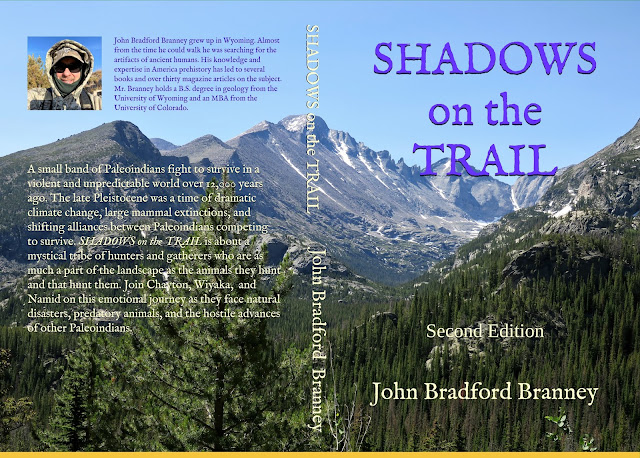 |
Figure 1 – 2.9 inch-long unifacial knife
form surface found on private land in
Niobrara County, Wyoming in the summer of
1975.
|
Over the decades, I have surface found several thousand prehistoric artifacts. Every artifact means something to me, but the artifacts I hold dearest in my heart are the ones I found as a young lad in my home state of Wyoming.
In the summer of 1973, my family visited a private ranch in Niobrara County, Wyoming to artifact hunt. The ranch was on the eastern slope of the forested Rawhide Buttes, which lies on the northeast portion of the Hartville Uplift. A lady in her late sixties or early seventies owned and ran the ranch. I remember the lady was tiny in stature, but I could tell that she was as tough as nails. If memory serves me, she had never been married and had lived on the family’s homestead since birth. The house was very small with two- or three-rooms, tops. I don’t remember if she had running water or electricity, but I am pretty sure she did. To say the least, this lady lived a very rustic lifestyle. We met this lady through her neighbors. We got to know her neighbors from church and they suggested we check out this lady’s artifact collection. The neighbors were good people and very close to this lady, helping her out as much as they could.
After the usual small talk with the lady, she showed us several mason jars full of
 |
Figure 2 – from Selected Preforms,
Points, and
Knives of the North American Indians – Volume I
by
Gregory Perino.
|
artifacts that she had found on her ranch and in the surrounding area. She poured the artifacts out onto the kitchen table and it became a feeding frenzy for me. She had quite a collection, lots of different projectile point types, tools, and materials. It was not a super large collection, but it had some unique artifacts in it. I remember thinking at the time that this lady hadn’t left much for us to find on her land. I vividly remember one unique type of arrow point she had in her collection. The arrow point looked like a tiny Christmas tree. The arrow point’s edges were heavily serrated, making the edges look like the branches on a pine tree. She had about five of these pine tree arrow points. I had never seen that type of arrow point on the high plains then and since, so I assumed that the same Late Prehistoric flintknapper made all five of them. The closest projectile point type that I know of that resembles those little Christmas tree points are Pine Tree points from the eastern and southeastern part of the United States. Of course, Pine Tree points are not true arrow points, they are much older and much larger, but the knapping concept was the same (figure 2).
I often wonder what happened to this lady’s artifact collection after she died. She was always close to the neighbors’ son who happened to be my age. He may have ended up with the collection, I just don’t know. This is a big problem with family collections – where they end up when the primary collector dies. I have the same problem with my collection, at this stage in my life I have no idea where my artifacts will end up.
 |
Figure 3 – 1.9-inch-long Pelican Lake dart /
knife form surface found on
private land in Niobrara County, Wyoming in the
summer of 1973.
|
We hunted for artifacts that first day, staying within a quarter to a half of a mile from the lady's house. I was convinced we would not find anything. I was already planning my next visit to the ranch without my family so that I could do some real exploring up in the forest and away from the house. Then I spotted it, half buried, one of the most beautiful “Glendo arrowheads” that I have ever found (figure 3). The lady seemed to have missed this multi-colored jasper beauty! Back in those days, we called corner notched points with barbed corners Glendo after the archaeological work done in 1957 by William Mulloy on the site for the new Glendo Reservoir in eastern Wyoming. Most collectors don’t use the term Glendo anymore. There are a handful of collectors who still call corner notched points with a rocker-style base (rounded and convex) Glendo, but for the most part the term Glendo point is passé. Most people now call these corner notched dart point and knife forms Pelican Lake after the work done by Boyd Wettlaufer at the Mortlach site in the early 1950s in central Saskatchewan.
 |
Figure 4 – Side profile of 2.9-inch-long
unifacial knife form showing curvature. Knife also seen in Figures 1 and 5. John Bradford Branney Collection.
|
Two years later in the summer of 1975, I was walking on that same lady’s ranch when I spotted a beautiful piece of dendritic jasper lying on the forest floor between piles of pine needles. I picked up the well-made unifacial knife form in figures 1, 4, and 5. I knew at the time it was special. I remember rushing home to check out Virgil Russell’s book titled Indian Artifacts. In the book, there was a knife form with a similar curved blade. Mr. Russell referred to that knife as a “scalping knife”. Calling it a “scalping knife” never sold me, but I did not know what else to call it. I still don’t, except for unifacial knife form. Since the knife form is not diagnostic to any one prehistoric culture, I cannot tell you who made it. I believe it was Paleoindian, but just because I believe something does not make it fact. I can say that I don’t have another knife like it. This artifact will always hold a special place in my heart.
I visited that ranch several times between 1973 and 1975, but never returned after that. I am not sure what happened to the lady, the ranch, or her artifacts. I found a few nice artifacts on that place, two of which I showed you today. Whenever I hunted that ranch, I always had that creeping feeling that I was fifty years too late for finding the really good stuff.
 |
Figure 5 – Opposite face of the 2.9-inch-long
unifacial knife form in figures 1 and 4.
|






No comments:
Post a Comment